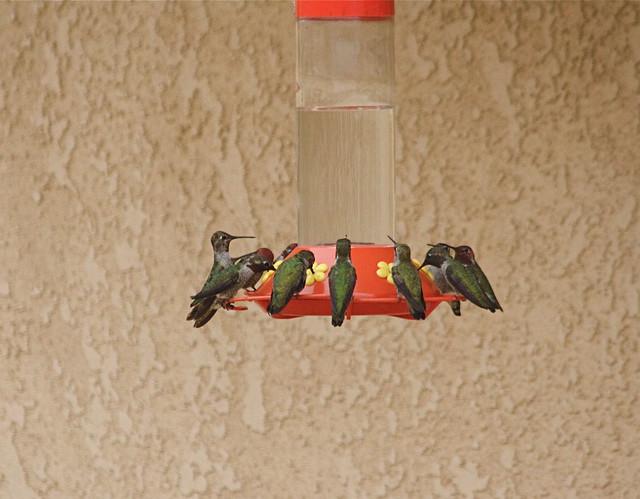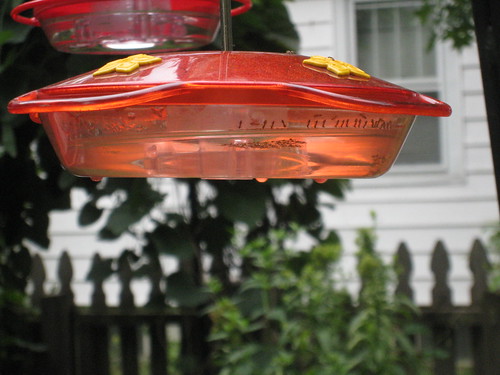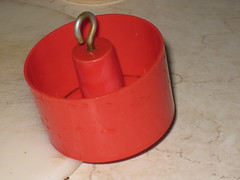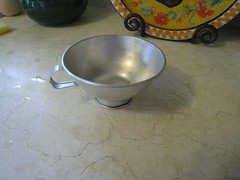 |
| So many hummers! This is my goal! Thanks to Teddy Llovet for the photo. |
2 cups hot tap water
1/2 cup sugar
That's really all there is to it, but I do have some refinements.
Now that I'm filling so many feeders, I mix up 6 cups at a time and store it in a juice pitcher in the fridge. I've read that it may be better for the birds to use sugar made from cane, not sugar made from beets, so I look for "cane sugar" on the package. Other than that, I buy what's on sale.
I use a jar funnel on the pitcher when I throw in the sugar. It reduces the mess a bit. Look for this type of funnel with the canning supplies in summer and fall. I put the lid on the pitcher and shake.
Do you find rafts of ants floating in your nectar feeder? You need an "ant moat." Ants follow a path down the wire/hook/hanger into the nectar, but they can't swim across a water barrier. Look for a feeder that has a "built-in ant moat" that you fill with plain water, or buy a separate moat.
Some fallacies about hummingbird nectar:
Not true: You have to boil the water.
If your tap water is safe for you to drink, it will be safe enough for the birds.
Not true: Use commercial nectar, which is red.
Natural nectar is never red, although the flower may be. Don't add artificial dyes to a hummingbird's diet needlessly. Just get a red feeder.
Not true: Honey is more natural than sugar.
Hummingbirds do not raid bee hives. They drink the nectar produced directly by plants. That nectar is sucrose, as is table sugar. Honey is a different type of sugar; mostly glucose and fructose. Even worse, honey can cause harm to the birds as it ferments.
Not true: You should train your hummers to use a more dilute solution by gradually decrease the amount of sugar.
First of all, you can't train "your hummers." Hummingbird banders tell me that most birds stay only a few days in an area before moving on.
This fallacy is based on the assumption that more sugar is bad for the bird. But most hummingbird-pollinated flowers have a 20% solution in their nectar, though some, like trumpet creeper (Campsis radicans) have up to 34%! See the Louisiana Ornithological Society's Newsletter, March 2003, "Sugar Content of Hummingbird Plants in Louisiana Gardens," by Dennis Demcheck here.
For a more thorough discussion of the proper concentration of sugar in a nectar feeder, check this discussion from the HumNet listserve.
PS: I received a comment through Facebook from Sheri Williamson, co-director and founder of Southeastern Arizona Bird Observatory. She suggested using cold tap water, since hot water may contain lead. The only reason I used hot water was to speed up the mixing of the sugar solution, so I can easily switch to cold water.
You might also enjoy:
Now that I'm filling so many feeders, I mix up 6 cups at a time and store it in a juice pitcher in the fridge. I've read that it may be better for the birds to use sugar made from cane, not sugar made from beets, so I look for "cane sugar" on the package. Other than that, I buy what's on sale.
I use a jar funnel on the pitcher when I throw in the sugar. It reduces the mess a bit. Look for this type of funnel with the canning supplies in summer and fall. I put the lid on the pitcher and shake.
 |
| Some feeders have a built-in "ant moat." Not this one. |
 |
| Stand-alone "ant moat." Just fill with water. |
Another cool thing about an ant moat with water is that it serves as a bird bath for small birds. I advise against using something called an "ant barrier." Usually it contains chemicals to deter the ants.
Not true: You have to boil the water.
If your tap water is safe for you to drink, it will be safe enough for the birds.
Not true: Use commercial nectar, which is red.
Natural nectar is never red, although the flower may be. Don't add artificial dyes to a hummingbird's diet needlessly. Just get a red feeder.
Not true: Honey is more natural than sugar.
Hummingbirds do not raid bee hives. They drink the nectar produced directly by plants. That nectar is sucrose, as is table sugar. Honey is a different type of sugar; mostly glucose and fructose. Even worse, honey can cause harm to the birds as it ferments.
Not true: You should train your hummers to use a more dilute solution by gradually decrease the amount of sugar.
First of all, you can't train "your hummers." Hummingbird banders tell me that most birds stay only a few days in an area before moving on.
This fallacy is based on the assumption that more sugar is bad for the bird. But most hummingbird-pollinated flowers have a 20% solution in their nectar, though some, like trumpet creeper (Campsis radicans) have up to 34%! See the Louisiana Ornithological Society's Newsletter, March 2003, "Sugar Content of Hummingbird Plants in Louisiana Gardens," by Dennis Demcheck here.
For a more thorough discussion of the proper concentration of sugar in a nectar feeder, check this discussion from the HumNet listserve.
PS: I received a comment through Facebook from Sheri Williamson, co-director and founder of Southeastern Arizona Bird Observatory. She suggested using cold tap water, since hot water may contain lead. The only reason I used hot water was to speed up the mixing of the sugar solution, so I can easily switch to cold water.
You might also enjoy:
 |
| They'd Rather Fight Than Switch |
 |
| Mexican Sage is a Hummer Magnet |


Wow!!! I'm lucky if we get a blue tit on our feeders, but there is no chance of us having something as exotic as hummingbird in our gardens in the UK.
ReplyDeleteGood luck with the feeders, what I like you blog is how similar yet completely different the wildlife is between the UK & the US.
Whenever I read your posts at Views of the Ock, I think, "Do we have a creature that fills that niche here too?" It's lots of fun to compare and contrast.
ReplyDeleteIt must be pretty tasty seeing the way they fight over it!
ReplyDeleteNeat, Anne. The best thing about feeders is that the hummingbirds will come in right close to you. I see them going after the Stachytarpheta flowers here, but the shrubs are a tad far away for a good view of the birds. It may be time to break down and buy a feeder!
ReplyDeleteI think so, even though you have to fill them, keep them clean, etc. I like the ones that I can stick on the kitchen window1
ReplyDeleteSo cute all those tiny little hummingbirds all together enjoying their meal and water!
ReplyDelete